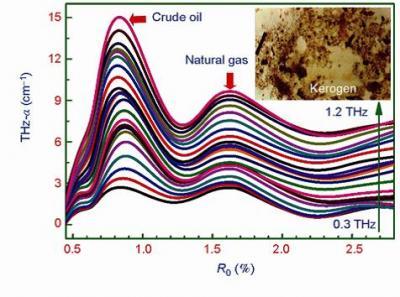A greater understanding of the evolutionary stage of kerogen for hydrocarbon generation would play a role in easing the world's current energy problem. Professor ZHAO Kun and his group from the Key Laboratory of Oil and Gas Terahertz Spectrum and Photoelectric Detection (CPCIF, China University of Petroleum, Beijing) set out to tackle this problem. After five years of innovative research, they have developed terahertz time-domain spectroscopy (THz-TDS) as an effective method to detect the generation of oil and gas from kerogen. Their work, entitled "Applying terahertz time-domain spectroscopy to probe the evolution of kerogen in close pyrolysis systems", was published in Science China Physics, Mechanics & Astronomy, 2013, Vol. 56(8).
The evolution stages of kerogen and hydrocarbon generation are critical aspects of oil-gas exploration and source rock evaluation. In sedimentary rock, about 95% of the organic matter is kerogen, the key intermediate in the formation of oil and gas. The specific kerogen type and maturity level will determine the characteristics of the hydrocarbons that will be generated. Previous research has led to two primary observations: (i) kerogen serves as a significant energy source as recoverable shale oil and coal where reserves far exceed the remaining petroleum reserves; and (ii) kerogen possesses a significant sorption capacity for organic compounds. Kerogen is primarily composed of alicyclics, aromatics, and other functional groups. Therefore, the ability to generate oil and gas from kerogen is determined primarily by its specific composition and structure. However, each generation technique has advantages and disadvantages within the specific parameters of the kerogen. Thus, there is a need for new methods to characterize the numerous stages and mechanisms of hydrocarbon generation from kerogen.
Vitrinite reflectance (R0%), defined as the proportion of normal incident light reflected by a polished planar surface of vitrinite (found in kerogen), is commonly used to characterize the maturity stage of kerogen. Those stages are defined as: the immature (IM) stage, where it generally cannot produce oil and gas (R0%<0.5); the early mature (EM) stage, or heavy oil zone (0.52.0).

This image shows R0% (vitrinite reflectance) dependence of α (absorption coefficients) of kerogen of different maturities at selected frequencies.
(Photo Credit: ©Science China Press)
To meet the challenges of applying optical characterization in oil and gas exploration, we applied THz-TDS as a nondestructive, contact-free tool for identifying the transformational paths and hydrocarbon generation ability of kerogen. Specifically, the absorption coefficients at different temperatures and pressures indicated the maturity regime of the kerogen, which were in good agreement with the results of programmed pyrolysis experiments.
By comparing the kerogen THz curves under different R0% and the maturity stages of the hydrocarbons, we can conclude that a relationship exists between the kerogen THz optical constants and the maturity stage. The THz optical constant curves at a given frequency can be divided into several sections denoted by the IM, EM, MM, LM, and OM stages. The kerogens cannot generate any significant amount of oil or gas when in the IM stage (R0%<0.5). Therefore, the functional groups and characteristics do not alter, which results in little observed change of the THz optical constants. In the primary oil generation zone (0.7
This study was a collaborative effect involving many university and company researchers. It was supported by a grant from the National Key Scientific Instruments and Equipment Development, a 973 grant from the Department of Science and Technology of China, and a grant from the Beijing National Science Foundation. Being nondestructive and contactless, this method has shown great promise to improve kerogen analysis. The technique needs to be applied in more instances that involve reservoir rocks and further research will determine whether it can be established as a key tool in petroleum exploration and impact the oil and gas industry.
Source: Science China Press